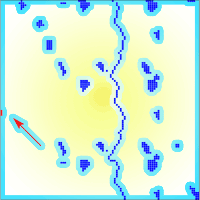
Characterization of two poplar homologs of the GRAS/SCL gene, which encodes a transcription factor putatively associated with salt tolerance
Vladislava Galovic (1) , Sasa Orlovic (1), Matthias Fladung (2)
iForest - Biogeosciences and Forestry, Volume 8, Issue 6, Pages 780-785 (2015)
doi: https://doi.org/10.3832/ifor1330-008
Published: May 19, 2015 - Copyright © 2015 SISEF
Research Articles
Collection/Special Issue: COST Action FP0905
Biosafety of forest transgenic trees and EU policy directives
Guest Editors: Cristina Vettori, Matthias Fladung
Abstract
To cope with soil salinity, which is one of the most severe forms of abiotic stress, efforts are being undertaken to enhance the salt tolerance of economically important poplar clones in the Vojvodina region of Serbia. One approach is to screen nucleotide diversity in candidate genes (CG) in several poplar clones of high economic importance to Serbia to search for associations with salt stress tolerance. As plant-specific GRAS/SCL transcription factors (TFs) play diverse roles in abiotic stress resistance, two poplar homologs of GRAS/SCL TFs were chosen to differentiate the species background with respect to salt tolerance. A BLAST search of the Populus trichocarpa genome using the P. euphratica gene GRAS/SCL TF_GH611858 sequence identified two putative orthologs, Scaf_5 and Scaf_7, with identities of 100% and 94%, respectively. Primers were designed in identical sequences of Scaf_5 and Scaf_7 to amplify fragments of GRAS/SCL TF orthologs in four poplar clones that are economically important to Serbia. The primers spanned regions where, at least in P. trichocarpa, single nucleotide polymorphisms (SNPs) are present, thereby increasing the probability of distinguishing Scaf_5 and Scaf_7 orthologs in the four clones. Alignments and analyses of the gene fragments revealed that both orthologs were representative of the genetic diversity between different poplar clones, and the identified SNP markers differentiated the four poplar clones with respect to salt tolerance.
Keywords
Candidate Gene, Nucleotide Polymorphism, Tree Genomics, Poplar
Authors’ Info
Authors’ address
Sasa Orlovic
University of Novi Sad, Institute of Lowland, Forestry and Environment, Antona Cehova 13, 21000 Novi Sad (Serbia)
Thuenen Institute of Forest Genetics, Sieker Landstr. 2, D-22927 Grosshansdorf (Germany)
Corresponding author
Paper Info
Citation
Galovic V, Orlovic S, Fladung M (2015). Characterization of two poplar homologs of the GRAS/SCL gene, which encodes a transcription factor putatively associated with salt tolerance. iForest 8: 780-785. - doi: 10.3832/ifor1330-008
Academic Editor
Marco Borghetti
Paper history
Received: Apr 29, 2014
Accepted: Feb 12, 2015
First online: May 19, 2015
Publication Date: Dec 01, 2015
Publication Time: 3.20 months
Copyright Information
© SISEF - The Italian Society of Silviculture and Forest Ecology 2015
Open Access
This article is distributed under the terms of the Creative Commons Attribution-Non Commercial 4.0 International (https://creativecommons.org/licenses/by-nc/4.0/), which permits unrestricted use, distribution, and reproduction in any medium, provided you give appropriate credit to the original author(s) and the source, provide a link to the Creative Commons license, and indicate if changes were made.
Web Metrics
Breakdown by View Type
Article Usage
Total Article Views: 52491
(from publication date up to now)
Breakdown by View Type
HTML Page Views: 44145
Abstract Page Views: 3282
PDF Downloads: 3678
Citation/Reference Downloads: 21
XML Downloads: 1365
Web Metrics
Days since publication: 3860
Overall contacts: 52491
Avg. contacts per week: 95.19
Citation Metrics
Article Citations
Article citations are based on data periodically collected from the Clarivate Web of Science web site
(last update: Mar 2025)
Total number of cites (since 2015): 5
Average cites per year: 0.45
Publication Metrics
by Dimensions ©
Articles citing this article
List of the papers citing this article based on CrossRef Cited-by.
References
Overview of DNA-based studies of genetic variability in poplars. Topola 179/180: 71-79. [in Serbian with English summary]
Gscholar
Significance of establishment of forest tree and shrub plantations for the stability and sustainable development of ecosystems in Vojvodina. Topola 181/182: 31-41. [in Serbian with English summary]
Gscholar
Anatomical and physiological research in a poplar breeding program. Topola 159/160: 69-80. [in Serbian with English summary]
Gscholar
The genome of black cottonwood, Populus trichocarpa (Torr. & Gray). Science 313 (5793): 1596-1604.
CrossRef | Gscholar
A summary review of interspecific breeding in the genus Populus L. In: Proceedings of the “14th Meeting of the Canadian Tree Improvement Association” Part 2. Fredericton (NB, Canada). Canadian Forest Service, Ottava, ON, Canada, pp. 107-123.
Gscholar

















